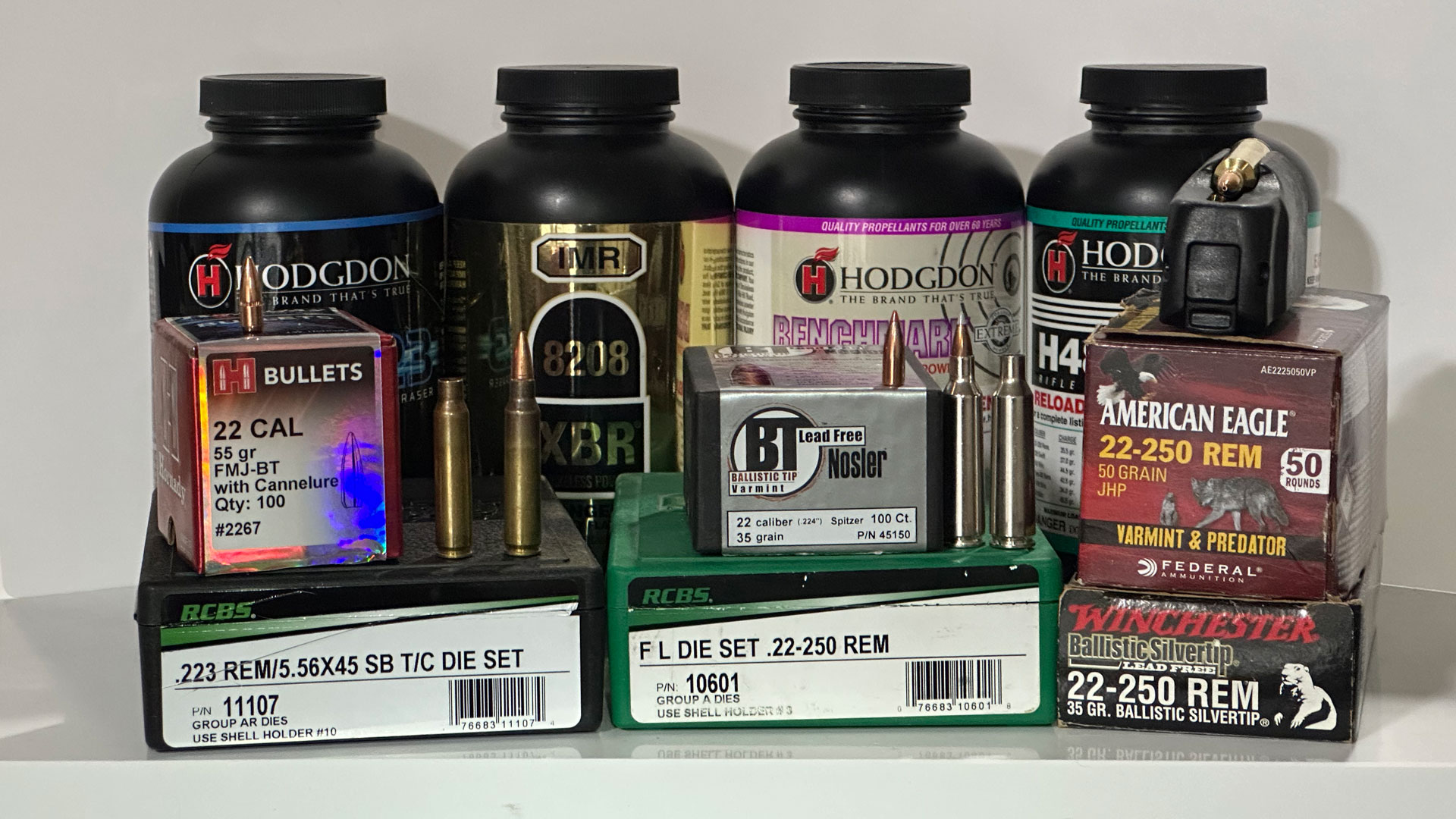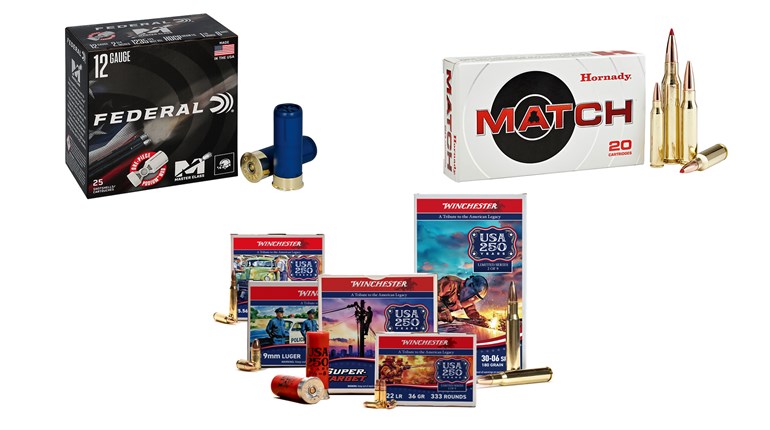
Bullet diameters often are tied to specific types of hunting. For instance, predators and varmints—think coyotes, feral hogs, bobcats and prairie dogs—are best handled with .22-caliber centerfire rifles, which is partially why the .223 Remington cartridge is so popular (its military backing being another primary reason). But there’s a cartridge that vastly outperforms the .223 Rem.—another .22-caliber cartridge also made by Remington—the .22-250 Remington.
For those not in the know, the .22-250 Remington has a long history. The cartridge started life as a wildcat, derived from the then-new .250/3000 Savage cartridge (released in 1915). The cartridge was necked up and down, and a group settled on a .224-diameter bullet, calling the wildcat the “.22 Varminter” in 1937. Browning introduced the first rifles in “.22 Varminter” in 1963. But it was still a handload-only proposition until Remington commercialized the cartridge (by putting its name on it, thereby making it “official”) in 1965. It’s longer than the .223 Rem., so it won’t fit in an AR-15 or a mini action, but it can run just fine in an AR-10 or short-action bolt gun. So why would you want to run Remington’s larger .22 cartridge over its shorter one? Pure speed.

Using the .224-caliber standard bullet weight of 55-grain bullets, the standard .223 Rem. cartridge propels projectiles at about 3,000 to 3,300 fps depending on powder and charge weight. While respectable, the .22-250 Rem. pushes the same bullet 300 to 600 fps faster than the fastest .223 Rem. load by comparison, again depending on powder and charge weight. That means there is far less drop and wind drift, as well as more energy imparted on target. Let’s look at an example using the fastest loads for each cartridge provided by Hodgdon’s reloading data.

The .22-250 is pushing a .55-grain bullet to 3,887 fps using 42.5 grains of Winchester StaBALL 6.5, while the .223 is pushing the identical bullet to 3,384 fps using a compressed charge of 27.5 grains of Varget powder. Almost 500 fps difference exactly. What does an extra 500 fps give the shooter? First, the shooter gets a much flatter trajectory. It doesn’t look like much up close, but as distance increases, the additional 500 fps starts to count—in my opinion, this occurs when drop difference is larger than an MOA-sized group at a given distance (1 inch at 100 yards, extrapolated at most to 10 inches at 1,000 yards). So based on the ballistic charts, this phenomenon occurs at merely 300 yards, as the .223 drops more than 3 inches compared to the .22-250 (10.4 inches compared to 7 inches respectively). Stretching this out to 1,000 yards, the 500 fps difference at the muzzle translates to 137 inches—nearly 4 yards—more drop at 1,000 yards when shooting the .223 Rem. compared to the .22-250 Rem.

And this is just one example. If we go to extremes, we see bullets as light as 35 grains listed in Hodgdon’s data. Be forewarned, this is where things can get weird depending on rifle twist rates. If your rifle uses a tight twist in the barrel, that helps with stabilizing heavier, longer bullets … which is great for heavier, longer bullets. Tight twists don’t necessarily hurt short bullets, but at extreme speeds like we’re about to see, issues can arise, which is why most .22-250 barrels either have tight, fast twist rates (think a 1:7 or a 1:8 like your standard AR) or a really slow twist (my Browning X-Bolt has a 1:14 twist rate). In other words, some barrels are spinning a .224-diameter bullet literally twice as fast as others. That said, I spoke with someone at Vista Outdoor many years ago, and they said they personally witnessed bullets being both spun so fast and pushed so fast that the projectiles came apart in flight. You can have one or the other, but not both, and it makes sense why; two forces acting in two directions on an object that, at its core, is made up of a soft, malleable metal (lead) isn’t going to hold up well against physics. The projectile in question, assuming it’s thrust from a barrel with a fast twist at top speed, is going to be rotating at just under 463,000 RPM while traveling nearly 4,500 fps. The frontal force of wind resistance and air density (plus humidity density), and the lateral centripetal force from the spin combine to be too much for a lead bullet with a thin copper jacket to handle. So, you’ve got to give up either speed or spin to make the bullet stable. While a .22-250 barrel nowadays can have a 1:7 twist for heavy bullets, having the case capacity to push the heavier bullets unlike the .223, the cartridge was still built for speed. This is why many .22-250 Rem. rifles have longer barrels (mine is 26 inches compared to most barrels being 20 to 24 inches long); they’re necessary to make the most out of the .22-250’s large case capacity relative to its bore size.

I’ve given a lot of numbers, but all that’s proven so far is, “Yeah, okay, it’s faster, and therefore has more energy and shoots flatter.” And while that’s plenty of reason for some, especially for hunters, it’s not the end-all-be-all for others. So, let’s talk about the guns and theory behind an action, and why you may rather have a .22-250 Rem. in a larger gun than a .223 Rem. in a smaller one.
First off, a rifle in a true short action rather than a Mini-Action like those from Howa, are a lot more common, and a lot more can be done with them when it comes to rechambering if you choose to do so later down the road. You’re relatively limited to a select few cartridges on rifles built on mini action lengths. Compounding that, aftermarket parts, such as stocks, magazines, and other accessories are far more common for a short action like a Rem. 700 compared to a Howa Mini Action. Second, specifically relating to semi-automatic firearms, you can still get a semi-auto .22-250 in the AR-10 platform, so you don’t loose any follow-up shot opportunities (which you’re far less likely to need, ironically, if you hit something with a .22-250 Rem. than with a standard .223 Rem.). Third, because the .22-250 has two clear twist rate concepts, bullet selection becomes important, and you truly can find a perfect bullet for your rifle’s twist rate for your intended purpose, yet still go the “jack of all trades, master of none” route if you so desire. With the .223 Rem. you can do that, but not to the same level of effectiveness because most .223 Rem. ammo sticks to the 55- to 62-grain loads. There actually is factory ammo using the much lighter bullet options in the .22-250, and it’s not mostly all FMJ or training ammo like in the .223 Rem. In other words, the .22-250 is the better .224-caliber hunting cartridge because of the specific bullets that tend to be loaded in the factory ammo. And by reloading, those options only expand. Yes, the same can be said for the .223 Rem., but again, the bullets won’t have the same effectiveness as they would when fired from the .22-250 Rem.
A few closing notes. Both cartridges can also be run through effectively the same guns; yes, the AR-10 is bigger than the AR-15, but realistically, the two function identically, and barring a few component differences, many AR-15 parts can be put on an AR-10. So, you lose nothing there. Same goes for a bolt-action rifle (which has its own benefits as mentioned). When all is said and done, the only benefit the .223 Rem. has going for it is availability… kind of. Next ammo scare, good luck finding any 5.56X45/.223 Rem. But I’d wager .22-250 might still be on some shelves depending on where you shop. All this to say that while the .223 Rem. does have its place, it’s hard to make the argument that its place is in hunting camp; simply put, anything the .223 Rem. can do, the .22-250 Rem. can do better.



































